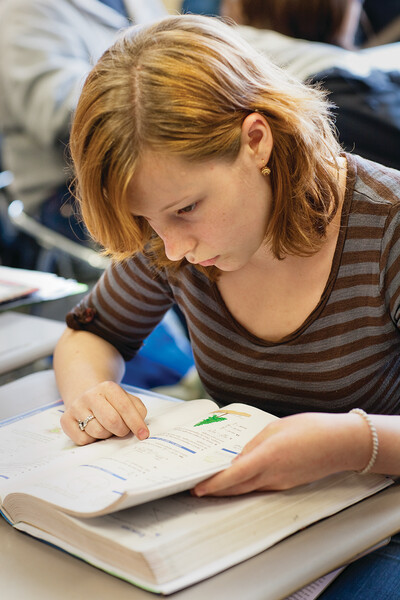Online Only
A Daily Dose of Literacy
Literacy Daily, the International Literacy Association's blog, is a source of inspiration and advice for K–8 educators looking to stay current on their knowledge of reading, writing, and speaking/listening instruction. On a weekly basis, bloggers review books—from early readers to young adult novels—and offer lesson recommendations to "put the books to work" in the classroom. The blog also provides tips to teach literacy using technology, practical ideas for strategy instruction, and creative project ideas. Visit Literacy Daily.
Research Alert
Teachers Gain an Understanding of Math Literacy
Both the Common Core State Standards and the National Council of Teachers of Mathematics' standards emphasize that students should learn to communicate mathematically, comprehending and creating a variety of oral and written mathematical arguments. Yet many teachers still don't see the relevance of reading for learning mathematics.
In a study published in the Journal of Literacy Research, researchers Helen M. Doerr and Codruta Temple detail how two 6th-grade teachers' thinking evolved to include a better understanding of the role of reading in mathematics instruction. The teachers collaborated with their peers and a team of math and literacy education experts to implement a new math curriculum adopted by their mid-sized urban district. At the beginning of the four-year implementation, the two teachers viewed math learning primarily as the mastery of computational skills. But by the end, they gained a deeper awareness of the literacy demands specific to mathematics, and they implemented many disciplinary literacy strategies in their classes. The researchers suggest that teacher-centered collaborations like this one are an effective way to build teachers' motivation and skill in designing disciplinary literacy instruction.
"'It's a Different Kind of Reading': Two Middle-Grade Teachers' Evolving Perspectives on Reading in Mathematics" is available for purchase.
Relevant Read
Making Curriculum Pop: Developing Literacies in All Content Areas by Pam Goble and Ryan R. Goble (Free Spirit Publishing, 2015)
When most of us hear the term text, we likely think of printed matter. The Gobles argue that we should expand our definition of "things that can be read" to a variety of other media, including art, movies, comics, and music. They propose a teaching model akin to Literature Circles 2.0, which incorporates print and nonprint texts, works across content areas, and uses roles that allow for whole-class, small-group, and individual work with texts.
The authors' model begins with a teacher choosing a rich, high-interest text for students to read. The teacher then invites readers to take on a role as they interact with the text. "Sensor," wordsmith, blogger, and casting director are just a few of the 55 roles. Students fill in a graphic organizer (called a Learning Experience Organizer, or LEO) that corresponds with their role. For instance, "sensors" will view a film and describe what they sensed, such as lighting and sound, and the feeling those elements created. The authors provide a reproducible LEO for each role.
The book, which is practical throughout, also features resources for choosing and using varying media text types—from advertising to visual arts—that can "make your curriculum pop."
Screen Grab
Rope Teens into Reading
Getting adolescents excited about the reading and writing they do in school is a tall order. For help, visit the video and multimedia section of WETA's AdLit.org—a trove of multimedia resources centered on young adult literature and teaching literacy to teens. The site's library of Common Core Classroom Video Modules, which includes clips of instruction in real classrooms, can be used for self-paced professional development. Users can also access interviews with literacy experts and stellar teachers who share how they have set up summer reading programs, improved reading comprehension, and made other impactful changes. Additionally, the site holds webcasts on topics like reaching English language learners, plus supplementary recommended readings and discussion questions.
Numbers of Note
Nonfiction, Fiction Gap Narrows
As a result of the Common Core State Standards' emphasis on "informational texts," teachers have put a greater focus on nonfiction reading. The line graph shows the percentage of 4th grade students whose teachers said they emphasize fiction and nonfiction to "a great extent."
Source: Loveless, T. (2016). Reading and Math in the Common Core Era. Washington, DC: Brookings Institution. Retrieved from www.brookings.edu/research/reading-and-math-in-the-common-core-era
Page Turner
"Disciplinary literacy is not a new name for content-area reading. They are different concepts, and both have value."



